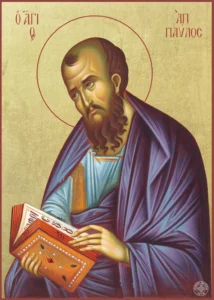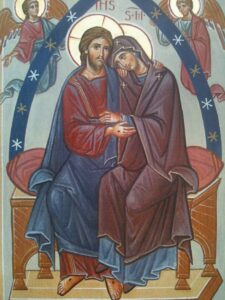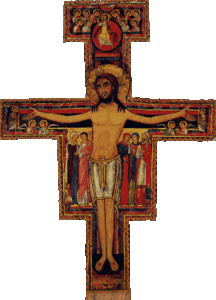The Resurrection of the Lord – The Mass of Easter Day – Option 2
Acts 10:34A, 37-43, Ps 118:1-2, 16-17, 22-23, Col 3:1-4, Jn 20:1-9
Dear brothers and sisters, first, on behalf of all of us, I want to wish you a very happy Easter. In a special way, too, we welcome everyone who is here visiting or who has come just to celebrate this special day with us, perhaps after a time away. We’re blessed to have you here for our celebration, since you really do make up part of our family here.
In today’s Gospel, we heard about two sets of visitors to Christ’s tomb; first, the arrival of Mary Magdalene, and then that of Peter and John. If we take a moment to consider these two sets, we can see some important truths for our lives, and some ways we can live out the joy of the Resurrection in our families.
First, we’re told that Mary Magdalene “came to the tomb early in the morning,
while it was still dark.” Only John’s Gospel tells us that “it was still dark” when Mary went to the tomb; all the other Gospels say that the first visitors came when it was already light. Really, they are saying the same thing: the word John uses for early means the last watch of the night, the time from 3 a.m. to 6 a.m., more or less.[1] If Mary was going to go to the tomb, she had to come when there was at least a little light, so she could see where she was headed; the sun was just breaking, but it could still be called dark.
This tells us that Mary Magdalene went as soon as possible to the tomb. Perhaps she spent the entire night awake, waiting until finally there was just barely enough light to walk towards the garden where the tomb lay. What drew her there was her great love for Jesus; she had sinned much in the past, but her great love covered those sins; “there are two ways of knowing how good and loving God is. One is by never losing Him, through the preservation of innocence, and the other is by finding Him after one has lost Him.”[2] Mary had lost God’s grace through her sins, but, once she found it again, she never wanted to lose it. Even when Christ was crucified and laid in the tomb, her soul sought the Only One who could bring her peace. Her love for Her Savior was so great that as soon as she could, she sought Him out, even though it seemed impossible that she would be able to do anything but mourn over Him.
In our lives, too, Christ always draws us to Himself. Sometimes, it’s through the feeling of unhappiness we have after we sin, because sin never makes anyone happy for very long. It could be the emptiness we feel when we have everything we think we want or need, and yet something is missing. Somehow, it’s just not enough. All of this is the way that God calls us to Himself, and bids us come to the empty tomb and to find Him, who is the Way, the Truth, and the Life. We can ask ourselves: do we really seek Jesus with all our hearts, as Mary Magdalene did? Do we seek Him in the midst of our difficulties, our temptations, and our challenges? Do we run to Him as soon as possible?
After Mary sees the stone removed and the body missing, she runs to get Peter and John, who, in turn, run off to the tomb. John arrives first, and Peter later. All of us feel that call to follow Christ, to seek Him. Some of us come to Christ faster, and others more slowly, but what is important is that we all seek Him sincerely, with all our hearts, and never relent until we reach our goal.
The disciples are confronted with a curious scene. Two details call our attention, first, the location of all the clothes and linens: Peter “went into the tomb and saw the burial cloths there, and the cloth that had covered his head, not with the burial cloths but rolled up in a separate place.” Second, we aren’t told that Peter believed, but rather that John “went in, and he saw and believed.” And, yet we’re also told that “they did not yet understand the Scripture that [Jesus] had to rise from the dead.”
The first detail calls our attention because literally what John says is that the burial clothes are “lying or resting there”[3]: “the clothes did not look as if they had been put off or taken off; they were lying there in their regular folds as if the body of Jesus had simply evaporated out of them.”[4] “They lay there like an empty cocoon. There was no sign of struggle; the graveclothes were not in disarray. Even the napkin (which had been wrapped around His face) was folded carefully in a place by itself.”[5]
Furthermore, as Saint John Chrysostom points out, the Gospel also tells us that Nicodemus “came bringing a mixture of myrrh and aloes weighing about one hundred pounds.” “Myrrh and aloes glue the cloths to the body so that they cannot be quickly removed.”[6] In other words, it was clear to the disciples that Christ’s body hadn’t been stolen in the dead of night, in haste, by graverobbers or by the Jews. Something special had happened.
The second detail is that John “went in, and he saw and believed,” and yet “did not yet understand the Scripture that [Jesus] had to rise from the dead.” Some say that John believed Mary, that the body had been taken, but not that the Resurrection had taken place. Others, though, say that John really did believe that Christ had risen from the dead, even though he didn’t understand how that fulfilled the Scriptures.
What is important for us, though, is that, sooner or later, based on what they have seen, the disciples will come to believe that Jesus has risen from the dead. These first signs, these first indications that something very special has taken place, serve as a gateway to deeper faith. Later the Roman soldiers and the Jews will say that the body of Jesus was stolen; this ignores the very clear evidence to the contrary.
In our lives, too, we have the opportunity to see all the many things around us as part of God’s providence and love for us, as ways that He manifests His love to us. The world is full of the blessings that God showers upon us, and we can either see these many things as His gifts, or ignore them, as those enemies of Christ did. The choice is ours: do we see everything as a gift, coming from His hands, or do we simply complain about the little things we have to endure, and refuse to celebrate the joy of the Resurrection and the new life that Christ wants to give us, if only we would turn to Him and seek Him with all our hearts?
As we enter this season of Easter joy, let us ask, through the intercession of Mary, Cause of our Joy, for the grace to truly trust in God, knowing that only in Him will our souls find peace and joy.
[1] Cf. Biblical Commentary of William Barclay.
[2] Fulton Sheen, Peace of Soul.
[3] Thayer’s Greek Lexicon: STRONGS NT 2749: κεῖμαι
[4] Cf. Biblical Commentary of William Barclay.
[5] The Wiersbe Bible Commentary: New Testament, 85.
[6] Saint Thomas Aquinas Commentary on the Gospel of Saint John, ch. 20, l. 1.






